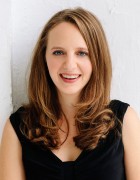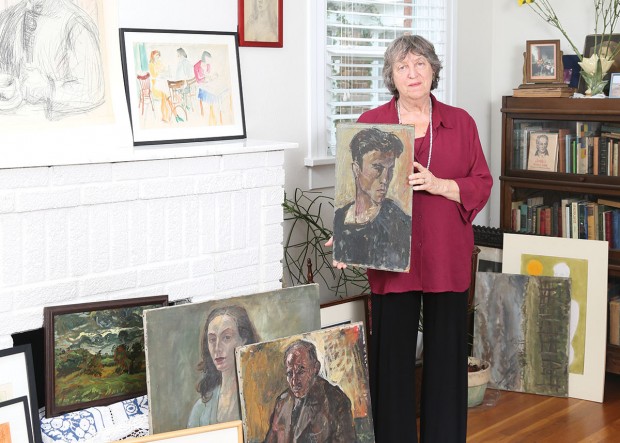Art in Exile
Miriam Murphy’s treasures


IRREPLACEABLE Miriam Murphy surrounds herself with her parents' artwork, family photos and keepsakes from England. She lives in an apartment now after her longtime Bellaire home flooded during Hurricane Harvey. (Photo: lawellphoto.com)
In the years following World War II, Miriam Murphy crawled past canvases and tried to teethe on paintbrushes on the top floor of a bright Victorian home in northwest London.
As a child, she watched her artist parents fill canvases with color. One day, her father, Hugo Dachinger, painted a from-memory portrait of a forlorn-looking teen he had met years earlier in an English internment camp.
An Austrian Jewish refugee and burgeoning artist, Dachinger spent seven months in camps in the late 1930s as an “enemy alien” before England released him. He passed his days painting, using newspapers soldiers discarded, paintbrushes made from sticks and strands of his hair, and paints mixed from ash and mud.
“My dad did his best and most dramatic work at this camp,” said Murphy, now 72. When her father died, Murphy donated many of his pieces to the Walker Art Gallery in Liverpool and a gallery on the Isle of Man, where her father was last interned. But she also shipped several crates of her parents’ artwork to herself in Houston, including the portrait of the teen. Her mother, Meta, was also a Jewish refugee who escaped Nuremberg, Germany. She specialized in painting watercolors.
Now, in a small extra room in the apartment Murphy rents, hundreds of her parents’ creations line walls and pile high on tables and shelves. They used to be in the Bellaire home she lived in for over three decades that she now is selling. As Hurricane Harvey dumped water into her home, Murphy watched from a neighbor’s, petrified the artwork would not survive.
But in the days following the storm, Murphy was relieved to find that Harvey ruined only a few of her parents’ creations. The bulk of the collection survived and offers insight into the refugee experience. Murphy surrounds herself with her parents’ paintings and sketches as concrete signs of her Eastern European Jewish heritage, her family’s luck during the war, and a hopeful reminder that even war can’t squash the spirit of an artist driven to create.
It all started in 1941 at the London Transport’s Lost Property Office. Meta had left an umbrella on a bus; Hugo misplaced his art portfolio.
Meta and one of her sisters recently had fled Germany for England and enrolled at the University of London. Hugo, from Gmunden, Austria, had escaped to Poland days before the Anschluss (when Hitler rolled into Austria), then made his way to Denmark, and after that London. He had recently been released from the internment camp following a recommendation from the Royal Academy of Arts, and he was determined to make a career for himself as an artist.
“My mother didn’t find her umbrella there, but she found her future husband,” said Murphy, who, in her apartment living room, sets a cup of proper English tea on the coffee table. A long strand of pearls hangs from her neck, well past her short gray hair.
For Murphy’s mother, it wasn’t love at first sight. But then Meta visited Hugo’s art studio. “She fell in love with his art, and then eventually with him,” Murphy said. “My parents highly respected each other’s work.”
Together, Murphy’s parents survived the Blitz, the German bombing offensive against Britain in 1940 and 1941, often by huddling in the London Underground. Murphy remembers the overgrown lot next to her home where she played still had a scorched smell. (Murphy, who ended up working as a school teacher in London, met a Texan studying in London, married him and left for Houston. She has since divorced.)
Many of Murphy’s father’s paintings are reminiscent of French artist Henri Matisse, marked by vivid colors and strong lines. In one 1942 drawing, Hugo used pastel crayons and wax – in purple, pink, orange and green – to draw artists painting a model. A watercolor depicts an English soldier drinking a beer in a pub.
Murphy’s father told her Sigmund Freud himself posed for a 1941 charcoal sketch Hugo did in a London café. Many of Hugo’s drawings document daily life in the English internment camp – detainees eating meals and Jews praying. At camp, he organized an exhibition entitled “Art Behind Barbed Wire,” and after his release, 40 of his works were exhibited in a top London gallery. Murphy’s mother painted less, usually nature scenes.
Murphy’s father excelled in art school, taught art and created thousands of paintings and drawings; his early work was lost in Austria during the war. He eventually took on work making novelty gifts to insert into women’s magazines, such as a set of flat, plastic crochet needles. But he never stopped painting.
After his death, Murphy found an Austrian art gallery owner who put together a book of her father’s work. Her mother’s work has not been widely shown. But one day, her daughter hopes to share her parents’ combined collection in a U.S. gallery.
Want more buzz like this? Sign up for our Morning Buzz emails.
To leave a comment, please log in or create an account with The Buzz Magazines, Disqus, Facebook, or Twitter. Or you may post as a guest.


